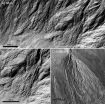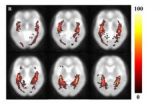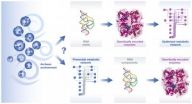(Press-News.org) Researchers from LSTM are among those who have sequenced the genome of a species of tsetse fly (Glossina morsitans). The outcomes of this research will be invaluable to understanding more about the tsetse and other insect vector biology, knowledge which can be applied to improving the current vector control methods and may lead to more effective and affordable control strategies.
A paper summarising some of the findings will be published in the journal Science today, with more specific and in depth analyses of various aspects of tsetse biology being published as a collection of 10 papers within the PLOS family of journals.
The tsetse fly is the vector for African trypanosomiasis, a potentially fatal disease in people (sleeping sickness) and livestock (Nagana), throughout sub-Saharan Africa, with an estimated 70 million people at risk of infection. Unlike other disease vectors, such as mosquitoes and sandflies, both sexes of the tsetse fly feed exclusively on vertebrate blood, meaning that all tsetse are capable of spreading the disease. To deal with the nourishment issues arising from feeding exclusively on blood the tsetse has formed complex relationships with three different symbiotic bacteria. It is also unusual among insects as it gives birth to live young having evolved to lactate in order to provide nourishment to intrauterine offspring.
The work was carried out over a 10 year period following the formation of the International Glossina Genome Initiative in 2003. Around 146 scientists have contributed to the work, including members of the departments of Vector Biology, Parasitology and Clinical Sciences within LSTM, along with colleagues from around the world, with at least half of the contributors being from African institutions.
LSTM's Professor Mike Lehane was a member of the project leadership team and describes the significance of the work: "Human infections with African trypanosomes can be fatal if left untreated. It has not been possible to develop a vaccine for the disease due to the ability of trypanosomes to evade the mammalian immune system, this coupled with the fact that there are some significant side-effects and reports of growing resistance to current trypanocidal drug treatments means that vector control strategies remain the best hope to eliminate the disease.
"The work that has been carried out by such a large group of international researchers and scientists has not been without its challenges, but has given us detailed information on a wide range of aspects of tsetse biology. It has provided us with a vital research tool, which will be continually added to over time and may well lead to control strategies that can bring an end to suffering caused by the disease both in terms of the human cost as well as the economic losses due to affected livestock."
INFORMATION:
As part of the satellite papers published by the PLOS journals, the group of Dr Acosta Serrano has also contributed with one in PLOS Neglected Tropical Diseases (Rose Clair, et al., 'An investigation into the protein composition of the teneral Glossina morsitans morsitans peritrophic matrix').
Note for Editors:
Those involved from LSTM are:
Mike Lehane, Lee R. Haines, Deirdre Walshe, CherPheng Ooi, Urvashi N. Ramphul, Stella Lehane, Alvaro Acosta Serrano, Clair Rose, Alistair Darby
Clair Rose was recently awarded the best student talk by the British Society of Parasitology in relation to her work on the satellite paper.
For further information, please contact:
Mrs Clare Bebb
Senior Media Officer
Liverpool School of Tropical Medicine
Office: +44 (0)151 705 3135
Mobile: +44 (0)7889535222
Email: c.bebb@liv.ac.uk
Liverpool School of Tropical Medicine (LSTM) has been engaged in the fight against infectious, debilitating and disabling diseases since 1898 and continues that tradition today with a research portfolio in excess of well over £200 million and a teaching programme attracting students from over 65 countries.
For further information, please visit: http://www.lstmliverpool.ac.uk
Researchers at LSTM part of the international team to sequence the tsetse genome
Genetic code of the tsetse sequenced and annotated
2014-04-25
ELSE PRESS RELEASES FROM THIS DATE:
Know your enemy
2014-04-25
Researchers at Aarhus University, Denmark, have drawn up the most detailed 'image of the enemy' to date of one of the body's most important players in the development of Parkinson's disease. This provides much greater understanding of the battle taking place when the disease occurs – knowledge that is necessary if we are to understand and treat Parkinsonism. However, it also raises an existential question because part of the conclusion is that we do not live forever!
Parkinson's disease is one of the most common neurological disorders, with about 7000 people suffering ...
3D printing cancer tumors
2014-04-25
Drexel's Wei Sun, PhD, Albert Soffa chair professor in the College of Engineering, has devised a method for 3D printing tumors that could soon be taking cancer research out of the petri dish.
Using a mixture of cervical cancer cells and a hydrogel substance that resembles an ointment balm, Sun can print out a tumor model that can be used for studying their growth and response to treatment. This living model will give cancer researchers a better look at how tumors behave and a more accurate measure of how they respond to treatment.
"This is the first time to report ...
Study reaffirms soy-dairy protein blend increases muscle mass
2014-04-25
A new study published online in the Journal of Applied Physiology shows additional benefits of consuming a blend of soy and dairy proteins after resistance exercise for building muscle mass. Researchers from the University of Texas Medical Branch found that using a protein blend of soy, casein and whey post-workout prolongs the delivery of select amino acids to the muscle for an hour longer than using whey alone. It also shows a prolonged increase in amino acid net balance across the leg muscle during early post-exercise recovery, suggesting prolonged muscle building. ...
Nitrogen pollution, climate and land use: Why what we eat matters
2014-04-25
A new report quantifies for the first time how much our food choices affect pollutant nitrogen emissions, climate change and land-use across Europe.
The executive summary of the European Nitrogen Assessment Special Report on Nitrogen and Food, 'Nitrogen on the Table', was released today (Friday 25 April 2014). The Special report provides an assessment of what would happen if Europe were to decrease its consumption of meat and dairy products. It shows how much cutting down on meat and dairy in our diets would reduce nitrogen air and water pollution, and greenhouse gas ...
A civil war inside our cells: Scientists show how our bodies fight off 'jumping genes'
2014-04-25
ANN ARBOR, Mich. — There's a civil war going on inside every one of the 37 trillion cells in your body. Now, University of Michigan scientists have uncovered how your cells keep this war from causing too much collateral damage.
On one side of the battle: your "regular" DNA, which provides the day-to-day instructions for life. On the other side: tiny bits of rogue DNA that hide like spies between genes in your own DNA. From time to time, these rogue bits of DNA spin off a copy of themselves and "jump" to another DNA location – often causing harmful mutations when they ...
Traces of recent water on Mars
2014-04-25
The southern hemisphere of Mars is home to a crater that contains very well-preserved gullies and debris flow deposits. The geomorphological attributes of these landforms provide evidence that they were formed by the action of liquid water in geologically recent time.
Evidence of liquid water
When sediment on a slope becomes saturated with water, the mixture may become too heavy to remain in place, leading to a flow of debris and water as a single-phase unit. This is called a debris flow. Debris flows on Earth often cause significant material destruction and even human ...
Tsetse fly genetic code sequenced
2014-04-25
Scientists at the University of Liverpool have been part of a ten-year project which has successfully sequenced the genetic code of the tsetse fly – making major advances in disease control possible.
Tsetse flies are unique to Africa and can infect people bitten by them with sleeping sickness, a disease which damages the nervous system and is fatal if untreated. This kills over 250,000 people each year.
Traditional methods of control such as releasing sterile males, trapping and pesticide spraying are expensive and difficult to implement. Sleeping sickness can also ...
Quantitative volumetric analysis of the optic radiation in the normal human brain
2014-04-25
The optic radiation is a dense fiber tract that emerges from the lateral geniculate nucleus and continues to the occipital visual cortex. Especially, the optic radiation is an important fiber structure that conveys visual information from the lateral geniculate nucleus to the primary visual cortex in the occipital lobe. Current studies have focused on the anatomical characteristics of optic radiation fiber tracts in individual brains and on comparisons of the anatomical characteristics of the optic radiation fiber tracts between patient and control groups. Therefore, no ...
Climate change: Don't wait until you can feel it
2014-04-25
Washington, D.C.— Despite overwhelming scientific evidence for the impending dangers of human-made climate change, policy decisions leading to substantial emissions reduction have been slow. New work from Carnegie's Katharine Ricke and Ken Caldeira focuses on the intersection between personal and global impacts. They find that even as extreme weather events influence those who experience them to support policy to address climate change, waiting for the majority of people to live through such conditions firsthand could delay meaningful action by decades. Their findings ...
Reconstructed ancient ocean reveals secrets about the origin of life
2014-04-25
HEIDELBERG, 25 April 2014 – Researchers from the University of Cambridge have published details about how the first organisms on Earth could have become metabolically active. The results, which are reported in the journal Molecular Systems Biology, permit scientists to speculate how primitive cells learned to synthesize their organic components – the molecules that form RNA, lipids and amino acids. The findings also suggest an order for the sequence of events that led to the origin of life.
A reconstruction of Earth's earliest ocean in the laboratory revealed the spontaneous ...
LAST 30 PRESS RELEASES:
Nanoplastics have diet-dependent impacts on digestive system health
Brain neuron death occurs throughout life and increases with age, a natural human protein drug may halt neuron death in Alzheimer’s disease
SPIE and CLP announce the recipients of the 2025 Advanced Photonics Young Innovator Award
Lessons from the Caldor Fire’s Christmas Valley ‘Miracle’
Ant societies rose by trading individual protection for collective power
Research reveals how ancient viral DNA shapes early embryonic development
A molecular gatekeeper that controls protein synthesis
New ‘cloaking device’ concept to shield sensitive tech from magnetic fields
Researchers show impact of mountain building and climate change on alpine biodiversity
Study models the transition from Neanderthals to modern humans in Europe
University of Phoenix College of Doctoral Studies releases white paper on AI-driven skilling to reduce burnout and restore worker autonomy
AIs fail at the game of visual “telephone”
The levers for a sustainable food system
Potential changes in US homelessness by ending federal support for housing first programs
Vulnerability of large language models to prompt injection when providing medical advice
Researchers develop new system for high-energy-density, long-life, multi-electron transfer bromine-based flow batteries
Ending federal support for housing first programs could increase U.S. homelessness by 5% in one year, new JAMA study finds
New research uncovers molecular ‘safety switch’ shielding cancers from immune attack
Bacteria resisting viral infection can still sink carbon to ocean floor
Younger biological age may increase depression risk in older women during COVID-19
Bharat Innovates 2026 National Basecamp Showcases India’s Most Promising Deep-Tech Ventures
Here’s what determines whether your income level rises or falls
SCIE indexation achievement: Celebrate with Space: Science & Technology
Children’s Hospital Colorado performs region’s first pediatric heart and liver dual organ transplant
Australian team discover why quantum computers have memory problems over time
What determines the fate of a T cell?
Candida auris: genetic process revealed which could be treatment target for deadly fungal disease
Groundbreaking discovery turns household plastic recycling into anti-cancer medication
Blocking a key inflammatory pathway improves liver structure and vascular function in cirrhosis, study finds
Continuous spread: Raccoon roundworm detected in nine European countries
[Press-News.org] Researchers at LSTM part of the international team to sequence the tsetse genomeGenetic code of the tsetse sequenced and annotated



